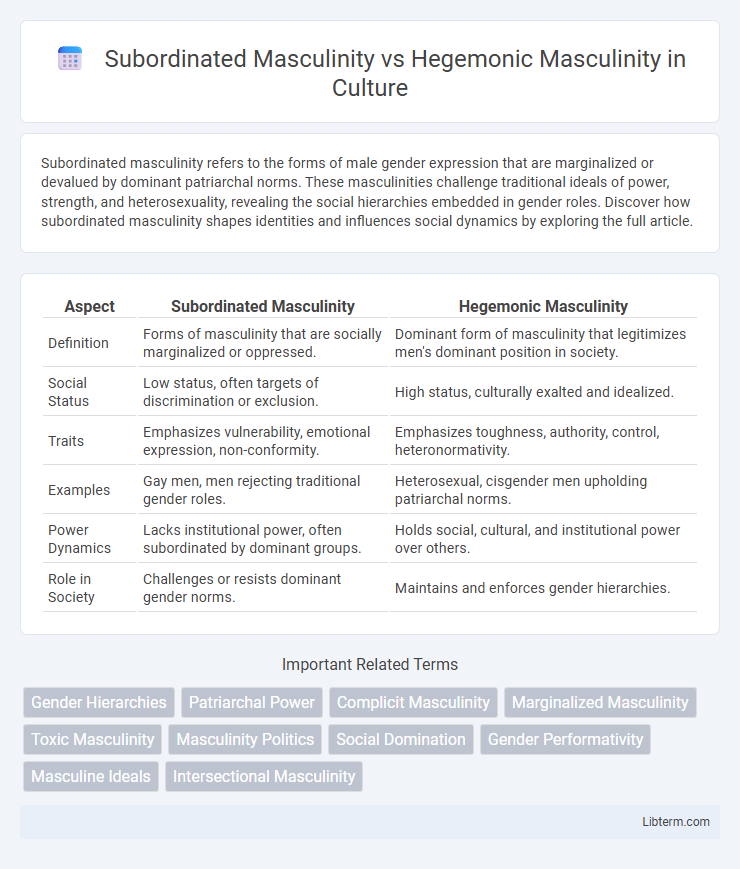Subordinated masculinity refers to the forms of male gender expression that are marginalized or devalued by dominant patriarchal norms. These masculinities challenge traditional ideals of power, strength, and heterosexuality, revealing the social hierarchies embedded in gender roles. Discover how subordinated masculinity shapes identities and influences social dynamics by exploring the full article.
Table of Comparison
| Aspect | Subordinated Masculinity | Hegemonic Masculinity |
|---|---|---|
| Definition | Forms of masculinity that are socially marginalized or oppressed. | Dominant form of masculinity that legitimizes men's dominant position in society. |
| Social Status | Low status, often targets of discrimination or exclusion. | High status, culturally exalted and idealized. |
| Traits | Emphasizes vulnerability, emotional expression, non-conformity. | Emphasizes toughness, authority, control, heteronormativity. |
| Examples | Gay men, men rejecting traditional gender roles. | Heterosexual, cisgender men upholding patriarchal norms. |
| Power Dynamics | Lacks institutional power, often subordinated by dominant groups. | Holds social, cultural, and institutional power over others. |
| Role in Society | Challenges or resists dominant gender norms. | Maintains and enforces gender hierarchies. |
Understanding Masculinity: Definitions and Frameworks
Subordinated masculinity refers to forms of masculinity marginalized and devalued within dominant social hierarchies, often associated with traits or identities considered less powerful or non-normative. Hegemonic masculinity represents the culturally exalted ideal of manhood, emphasizing authority, heterosexuality, and dominance over other masculinities and social groups. Understanding masculinity requires analyzing these frameworks to reveal how power dynamics and social structures shape gender identities and sustain inequalities.
What is Hegemonic Masculinity? Key Characteristics
Hegemonic masculinity is a culturally dominant ideal of manhood that legitimizes men's dominant position in society and justifies the subordination of women and other masculinities. Key characteristics include authority, control over resources, emotional restraint, physical toughness, heterosexuality, and the rejection of vulnerability. This form of masculinity often marginalizes subordinated masculinities that do not conform to its standards or lack power and social dominance.
Unpacking Subordinated Masculinity: Meaning and Examples
Subordinated masculinity refers to forms of masculinity that are marginalized or devalued within a society's dominant gender hierarchy, often contrasting with hegemonic masculinity, which embodies the culturally idealized manhood associated with power and authority. Examples of subordinated masculinity include expressions linked to homosexuality, emotional vulnerability, or non-conformity to traditional masculine norms, illustrating how social structures privilege hegemonic ideals while subordinating others. This dynamic reveals how gender identities are policed and stratified, affecting access to resources, social status, and personal agency among men.
Historical Contexts of Hegemonic and Subordinated Masculinities
Hegemonic masculinity historically emerged as the dominant cultural ideal, shaped by patriarchal values that reinforced male authority and social hierarchy in Western societies since the late 19th century. Subordinated masculinities have often been marginalized through class, race, and sexual orientation, reflecting power imbalances and exclusion from dominant male norms. These historical contexts reveal how hegemonic masculinity maintains social dominance by subordinating alternative masculinities, thereby perpetuating gender inequalities over time.
Power Dynamics Between Masculinity Types
Subordinated masculinity lacks the social power and dominance associated with hegemonic masculinity, which sets the ideal standard for male behavior in society. Hegemonic masculinity maintains control by marginalizing subordinated masculinities through cultural norms and institutional practices that reinforce dominance and privilege. Power dynamics between these masculinity types manifest in unequal access to resources, social status, and authority, perpetuating hierarchies that prioritize hegemonic traits such as assertiveness, competitiveness, and emotional restraint.
Social Impacts of Hegemonic Versus Subordinated Masculinity
Hegemonic masculinity enforces dominant social norms that perpetuate gender inequalities, reinforcing power hierarchies and marginalizing subordinated masculinities often associated with vulnerability or non-conformity. The social impacts of hegemonic masculinity include promoting aggressive behaviors, limiting emotional expression, and sustaining toxic masculine ideals that influence workplace dynamics, family roles, and mental health outcomes. Conversely, subordinated masculinities challenge dominant norms by exposing the fluidity of gender roles, fostering inclusivity, and providing alternative models that contribute to social change and greater gender equity.
Representation in Media and Popular Culture
Subordinated masculinity often appears in media and popular culture as marginalized or comedic, contrasting sharply with hegemonic masculinity, which is depicted as dominant, powerful, and idealized. Representations of hegemonic masculinity reinforce traditional norms of strength, authority, and heterosexuality, influencing societal expectations and gender roles. This dynamic creates a hierarchy where subordinated masculinities are stereotyped or excluded, shaping public perception and limiting diverse expressions of male identity.
Intersectionality: Race, Class, and Masculine Hierarchies
Subordinated masculinity is shaped by exclusion from hegemonic masculine ideals, often intersecting with race and class to reinforce social hierarchies where hegemonic masculinity privileges whiteness, economic power, and social dominance. Black and working-class men frequently experience subordinated masculinity due to systemic marginalization, racial stereotypes, and limited access to institutional power that uphold hegemonic standards. Understanding masculine hierarchies requires analyzing how race, class, and gender intersect to produce complex layers of privilege and subordination within masculinities.
Challenging Hegemonic Masculinity: Movements and Solutions
Challenging hegemonic masculinity involves social movements such as feminism, LGBTQ+ advocacy, and progressive masculinity initiatives that seek to deconstruct traditional power hierarchies and promote inclusivity. These movements emphasize the validation of subordinated masculinities, encouraging emotional expression, gender equality, and the dismantling of toxic masculinity norms. Educational programs, media representation, and policy reforms play critical roles in shifting public attitudes and fostering diverse expressions of masculinity beyond hegemonic dominance.
Toward Inclusive Masculinity: Redefining Gender Roles
Subordinated masculinity challenges hegemonic masculinity by highlighting the diverse expressions of male identity that resist dominant norms of power and aggression. Toward inclusive masculinity promotes embracing multiple masculinities, which fosters gender equality and reduces homophobia by redefining rigid gender roles and expectations. This approach encourages emotional openness, vulnerability, and egalitarian relationships, creating space for varied masculine identities beyond traditional dominance.
Subordinated Masculinity Infographic

 libterm.com
libterm.com